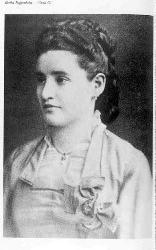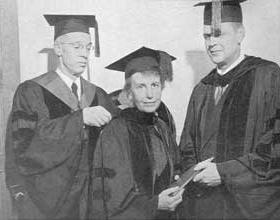"Human personality in principledevelops according to steps predetermined in the growing person's readiness tobe driven toward, to be aware of and to interact with a widening social radius."
--- Erik Erikson
Best Known For
- Erik Erikson has been called "father of psychosocial development" and "the architect of identity"
Birth
Erik Erikson was born in Frankfurt, Germany on June 15, 1902.
Erik Erikson die in Harwich, Massachusetts, 1994.
Childhood
Erikson's biological father, who was Danish, had left before Erikson was born.He was adopted by his Jewish stepfather, and took the name Erik Homberger. Butbecause of his blond-and-blue-eyed Nordic look, Erikson was rejected by his Jewishneighbors. At grammar school, on the other hand, he was teased for being Jewish.Feeling not fitting in with either culture, Erikson's identity crises began atan early age.
Other Life Events
- Around 1920, instead of going to college (for disliking the formal education structure), Erikson traveled around Europe, keeping a diary of his experiences.
- Came to the U.S. in 1933 and became Boston's first child analyst.
Career
He was an artist and a teacher in the late 1920's when he met Anna , andbegan to study child psychoanalyses from her and at the Vienna Psychoanalytic Institute.He immigrated to the United States in 1933. He obtained a position at the HarvardMedical School, and later on, held positions at institutions including Yale, Berkeley,the Menninger Foundation, the Center for Advanced Study in the Behavioral Sciencesat Palo Alto, and the Mount Zion Hospital in San Francisco.
His special interest in the influence of society and culture on child developmenthad led him to study groups of AmErikan Indian children. He was also concernedwith the effects the rapid social changes in AmErika on generation gap, racialtensions, juvenile delinquency, changing sexual roles, and the dangers of nuclearwar. He is credited for widening the scope of psychoanalytic theory to take greateraccount of social, cultural, and other environmental factors.
Publications by Erikson
- Erikson, E.H. (1950).Childhood and Society.New York: Norton.
- Erikson, E.H. (1958).Young Man Luther.New York: Norton.
- Erikson, E.H. (1964).Insight and Responsibility.New York: Norton.
- Erikson, E.H. (1968).Identity: Youth and Crisis.New York: Norton.
- Erikson, E.H. (1974).Dimensions of a New Identity.New York: Norton.
- Erikson, E.H. (1975).Life History and the Historical Moment.New York: Norton.
- Erikson, E.H. & Erikson, J. M. (1987).The Life Cycle Completed. W.W. Norton & Co.
- Erikson, E.H. (1996).Dialogue With Erik Erikson.Richard I. Evans (Ed.), Jason Aronson.
Biographies of Erikson
- Friedman, L. J. (1999).Identity's Architect; A Biography of Erik H. Erikson.Scribner Book Co.
- Coles, R. (1970).Erik H. Erikson: The Growth of His Work.Boston: Little, Brown.




